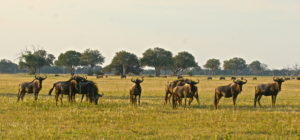7 Amazing Facts about the Great Wildebeest Migration
Posted on March 10, 2017, featured in Press
The mere mention of the “Wildebeest Migration” brings to mind visions of countless gnu racing past predators, diving into croc-infested rivers, stampeding across endless plains—all following the rain in search of food and water.

Everything you can imagine and so much more, the Great Migration is one of the most truly amazing displays on the planet. And while many of us, at one time or another, have seen images or footage of this breathtaking spectacle in books, on television, or online, it doesn’t come close to experiencing it firsthand. Here are some interesting facts to help bring you a little closer to this natural wonder of the world.
1. The Great Migration is the largest in the world. This stunning spectacle consists of over 1.5 million wildebeests (also called gnus), 200, 000 zebras, and a wide variety of other animals, including antelope, gazelle, and impala.
2. The Great Migration is not only the largest overland migration in the world, it’s also the longest. Mass herds of gnu journey an astounding 800 km (500 miles) or more during each migration cycle.
3. At the start of the migration period, approximately 400,000 wildebeest calves are born each year between January and March. Remarkably, fawns can run alongside their moms within minutes of being born, reaching speeds up to 64 km/h (40 mph).
4. Sure, there are over a million wildebeest on the move, but that doesn’t mean they make the same trek all together. If they did, huge numbers of gnu would starve. To ensure there is enough food for the entire herd, they split into several sub groups called “mega herds.” The smaller, separate groups follow a slightly different path, while still traveling in the same direction.
5. When it comes to protecting the herd from predators, there’s definitely strength in numbers. That is precisely why zebras travel along with the gnus. Plus, there is no need to worry about competing for food—they each graze on different parts of the same grass.
6. If you think the Great Migration is as old as Africa itself, you’d be wrong. Surprisingly, this natural phenomenon began in the 1960’s.
7. The migration is responsible for the deaths of approximately 250,000 wildebeests and 30,000 zebras each year. This is due to a number of reasons, such as thirst, hunger, exhaustion, and stampedes. And with over 3000 lions following the migration, and countless hungry crocodiles lurking in the waters below, eagerly anticipating the river crossings, it’s easy to see why predation also plays a major role in thinning out the herds.
Everyone should experience the Great Wildebeest Migration at least once in their life. There is absolutely nothing like it on earth. And while there is a traditional high season, the migration never really stops, meaning you can get a chance to witness this natural wonder throughout the entire year.
If the Great Migration is on your bucket list, let Sikeleli Africa Safaris craft an unforgettable tailor-made safari for you!
For custom safaris in Africa, contact us today!





